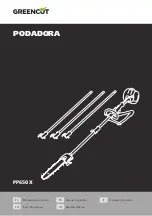
Page 23
the “No-Hands Zone”, as marked on the
saw table, or at least 3.25” away from
the blade. Never perform any cutting
operation “freehand” (i.e., without
holding the work piece against the
fence), because the blade could grab
the work piece, causing it to slip and
twist.
CAUTION Never use another person
as an additional support for a work
piece that is longer or wider than the
basic saw table, or to help feed,
support, or pull the work piece.
NOTE: When cutting a long work
piece, use the side extension block or a
3.0” high block (not supplied) to
support the work piece.
NOTE: Never operate the saw
without all guards securely in place and
in good operating condition.
CHOP CUTS
Chop cuts are used mainly for narrow
pieces. During chop cut, the saw arm is
pushed towards the end and the slide-lock
knob is fixed.
WARNING Failure to unplug the saw
could result in accidental start up,
which may cause serious injury.
WARNING Use a clamping position
that does not interfere with the cutting
operation.
NOTE: This tool has multi-slide bar
of two sections. Each section can be
locked / unlocked by its own locking
knob.
Step 1: Unplug the saw.
Step 2: Loosen the slide-lock knobs to
release the multi-slide bars.
Step 3: Push and slide the saw arm to the
rear as far as it will go (Fig. 26).
Step 4: Tighten the slide-lock knobs.
Step 5: Properly position the work piece.
Make sure that the work piece is clamped
firmly against the table and the fence.
Ensure the work piece clamp does not
interfere with the cutting operation.
Step 6: Plug the saw into a power source.
Step 7: Before turning the saw on, lower
the saw arm to make sure that the clamp
clears the moveable safety guard and the
saw arm.
Step 8: Squeeze On/Off trigger. Always
allow the blade to reach full speed before
cutting. Lower the saw arm while open the
moveable safety guard to make the cut.
Step 9: After finishing the cut, release
trigger and wait until blade comes to a
complete stop before returning the saw
arm to the raised position
Step 10: Remove the work piece and
repeat. When cutting a long work piece or
do repeated cutting, use extension table
and length stop.
SLIDE CUTS
Slide cuts are used mainly for wide pieces.
During slide cut, the slide-lock knob is
loosened and the saw arm is pulled
towards the operator before triggered on.
When cutting, the saw arm is lowered to
the work piece and then pushed to the rear
of the saw to make the cut.
WARNING Never pull the saw toward
you during a cut. The blade can
suddenly climb up on top of the work
piece and force itself toward you.
WARNING Failure to unplug the saw
could result in accidental start up,
which may cause serious injury.
WARNING Use a clamping position
that does not interfere with the cutting
operation.
NOTE: This tool has multi-slide bar
of two sections. Each section can be
locked / unlocked by its own locking
knob.
Step 1: Unplug the saw.
Step2: Loosen the slide-lock knobs to
release the multi - slide bars.
Step3: Pull the saw arm toward the
operator until the blade clears the front of
the work piece or to its maximum
extension (Fig. 27).
Step 4: Properly position the work piece.
Make sure that the work piece is clamped
firmly against the table and the fence.
Ensure the work piece clamp does not
interfere with the cutting operation.
(Continued on page 24)
FIG. 26
OPERATION










































